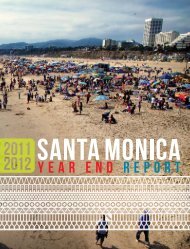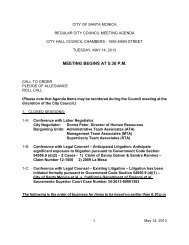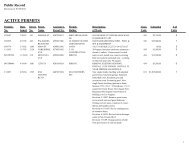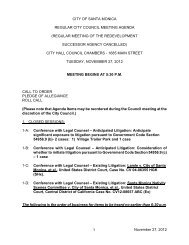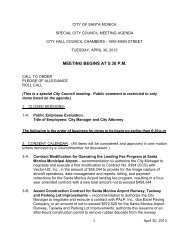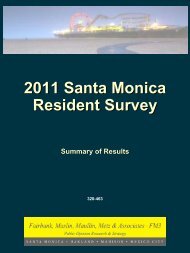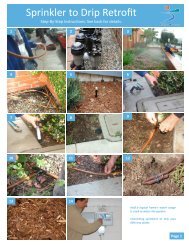Santa Monica Urban Forest Master Plan Task Force - City of Santa ...
Santa Monica Urban Forest Master Plan Task Force - City of Santa ...
Santa Monica Urban Forest Master Plan Task Force - City of Santa ...
Create successful ePaper yourself
Turn your PDF publications into a flip-book with our unique Google optimized e-Paper software.
+<br />
Presentation by Ad Hoc<br />
Subcommittee on Tree Selection<br />
Susan McCarthy, Peter Jensen,<br />
Dryden Helgoe & Grace Phillips<br />
<strong>Santa</strong> <strong>Monica</strong> <strong>Urban</strong><br />
<strong>Forest</strong> <strong>Master</strong> <strong>Plan</strong> <strong>Task</strong><br />
<strong>Force</strong><br />
June 2, 2011
+<br />
TASK FORCE SUBCOMMITTEE<br />
• Susan McCarthy: former <strong>City</strong> Manager, <strong>Santa</strong><br />
<strong>Monica</strong><br />
• Peter Jensen: Landscape Architect; Certified<br />
Arborist<br />
• Grace Phillips: <strong>Task</strong> <strong>Force</strong> Member; Landscape<br />
Designer; <strong>Urban</strong> <strong>Plan</strong>ning <strong>Master</strong>’s Candidate,<br />
UCLA<br />
• Dryden Helgoe: Landscape Designer, Recreation<br />
& Parks Commission Liaison
+ Why street trees?<br />
• PRAGMATIC REASONS: Allan Jacobs, a famous urban<br />
designer, wrote:<br />
• “If you want to make a major positive impact on an existing<br />
street and had a limited budget, you might well recommend<br />
planting trees as the way to get the most impact for your<br />
money.”<br />
• Street trees increase adjacent property values<br />
• AESTHETIC REASONS: Trees are “gifts to the street”<br />
• They create a sense <strong>of</strong> place, an image <strong>of</strong> order, a unifying<br />
element<br />
• They hide overhead wires, reduce the monotony <strong>of</strong> concrete and<br />
asphalt<br />
• They attenuate noise
+<br />
• HEALTH REASONS<br />
• They cool and clean the air<br />
• They protect pedestrians from traffic lanes<br />
• They provide shade<br />
• …these are just some <strong>of</strong> the reasons we love<br />
street trees!
+<br />
THE TASK FORCE MISSION<br />
•“…to ensure that the environmental,<br />
social, aesthetic and economic benefits <strong>of</strong><br />
a healthy community forest are available<br />
to <strong>Santa</strong> <strong>Monica</strong> residents and visitors for<br />
generations to come...<br />
•…the <strong>Master</strong> <strong>Plan</strong> will guide the<br />
conservation and enhancement <strong>of</strong> tree<br />
canopy coverage over the entire <strong>City</strong>…”
+ START WITH WHAT IS THERE
+ Appreciate what is working<br />
• Mature, healthy canopy in large parts <strong>of</strong> the city<br />
• Beauty <strong>of</strong> both monocultures (street planted with one kind <strong>of</strong><br />
tree only) and mixed stands (street planted with more than<br />
one species <strong>of</strong> tree)<br />
• Benefits <strong>of</strong> a good canopy – shade, sense <strong>of</strong> scale, specific<br />
character, rain water absorption, air quality, habitat (hawks’<br />
nest in a ficus tree on Delaware!)<br />
• Desirability <strong>of</strong> streets with beautiful canopies – nice street<br />
trees make houses more valuable<br />
• Street trees for way-finding: we use how streets look to<br />
navigate the city and find where we are going (“Look at this<br />
gorgeous allee <strong>of</strong> Casuarinas -- I must be on 26 th Street!”)
+ GET COMMUNITY INPUT<br />
• <strong>Task</strong> <strong>Force</strong> implemented outreach efforts through:<br />
• <strong>City</strong>wide community workshops<br />
• 30,000 door hanger questionnaires<br />
• On-line survey
+ Doorhanger Survey/Workshop Announcement<br />
Distribution<br />
• 30,000 doorhangers citywide<br />
Sustainability<br />
• 100% post-consumer recycled material<br />
• soy-based inks<br />
• locally printed<br />
• distributed by city maintenance crews on foot<br />
Return<br />
• nearly 300 surveys returned (1%)<br />
• ~75% <strong>of</strong> attendance at workshops
+ Online Survey<br />
Hosted by surveymonkey.com:<br />
• Publicized through<br />
• <strong>Santa</strong> <strong>Monica</strong> Daily Press<br />
• <strong>Santa</strong> <strong>Monica</strong> Mirror<br />
• <strong>City</strong>wide door hanger distribution<br />
• Link from smgov.net<br />
Response:<br />
• Total started survey: 236<br />
• Total completed survey: 223 (94.5%)<br />
• Many comments & replies
+ Community Workshops
+ Table Discussion Groups
+ What neighborhood do you live in?
+ What type <strong>of</strong> residence do you live in?
Considering the following characteristics <strong>of</strong> street trees,<br />
please tell us what is most important to you.
If you could choose the type <strong>of</strong> street tree for your<br />
street, what would you prefer?
+ Pr<strong>of</strong>ile/Combination Results from Community Input<br />
(Listed in order <strong>of</strong> Preference)<br />
1. Broadleaved Evergreen Monoculture<br />
2. Broadleaved Evergreen & Deciduous<br />
3. Narrow leaved Evergreen & Deciduous<br />
4. Deciduous Monoculture<br />
5. Combination <strong>of</strong> narrow leaved Evergreen Species<br />
6. Broadleaved Evergreen & Deciduous with Similar Form<br />
7. Broadleaved Evergreen & narrow leaved Evergreen<br />
8. Combination <strong>of</strong> multiple evergreen Species<br />
9. Palm Monoculture (compact spacing)<br />
10. Palm & Deciduous<br />
11. Palm & narrow leaved evergreen<br />
12. Combination <strong>of</strong> Palm Species<br />
13. Palm Monoculture (wide spacing)<br />
14. Palm & Broadleaved Evergreen
Community Input - Top 3 Choices<br />
+<br />
1 st Choice – Broad leaved Evergreen Monoculture<br />
2 nd Choice – Broad leaved Evergreen & Deciduous<br />
3 rd Choice – Narrow leaved Evergreen & Deciduous
+ What are our urban forest issues?<br />
• Dependence on too few species in the “Top 15” – one disease<br />
could decimate the forest<br />
• Age – trees nearing the end <strong>of</strong> their lifespan (Prunus<br />
carolinianas planted in the 60s, Bottle trees on Pearl Street)<br />
• Disease – various diseases are attacking certain species<br />
(Pittosporum family is dying from xylella, carried by the glassywing<br />
sharp shooter; oleander leaf scorch killing oleanders;<br />
fusarium infecting Canary Island Date Palms )<br />
• Lack <strong>of</strong> unity in plantings<br />
• Some streets are underplanted (the street needs more and/or<br />
bigger trees)<br />
• Some streets are overplanted (trees are too big for grow space)<br />
• CANOPY EQUITY: Due to how city parkways were laid out, some<br />
parts <strong>of</strong> town have far less canopy coverage than others
+<br />
The Poster Tree for <strong>Urban</strong> <strong>Forest</strong> Renewal
+<br />
OUR TASK:<br />
to boldly go where no other ad hoc tree selection subcommittee has gone before…<br />
•To go through the city street<br />
by street and <strong>of</strong>ten block by block<br />
and consider all current conditions<br />
<strong>of</strong> tree sites<br />
•To take as many variables<br />
and as much information into<br />
account when selecting tree<br />
species for the Long Range <strong>Master</strong><br />
<strong>Plan</strong>
+ Our task:<br />
•STEP ONE – define segments<br />
• Stretches <strong>of</strong> single streets with consistent parkway sizes<br />
that are visually continuous are treated as a single site (e.g.,<br />
15 th Street from Montana Avenue to Washington Avenue)<br />
•STEP TWO – refine lists<br />
• Review and revise List <strong>of</strong> Trees from Artecho, including<br />
scouring all sources for possible new additions (<strong>Santa</strong><br />
Barbara tree lists, native CA tree lists, tree experts in the<br />
region, etc.)<br />
• What species are over-represented in the city? How many<br />
<strong>of</strong> each in the Top 15 do we already have?<br />
• Lists are sorted by parkway size, alphabetically, and by<br />
mature size
+ STEP THREE –<br />
analyze site + conditions<br />
• What are the site conditions?<br />
• How wide is the parkway?<br />
• How wide is the street? Narrow streets can benefit from<br />
smaller trees, while wider ones generally need larger<br />
trees<br />
• What is the above-ground grow space? Are there<br />
adjacent two-story buildings? What shape <strong>of</strong> tree would<br />
be best in this site? Vase shaped, broad canopy, upright<br />
column?<br />
• What is the soil like? Is it sandy or solid clay?<br />
• What are the weather conditions specifically for this site?<br />
Is it in the fog belt?<br />
• How is the street used? Is there a lot <strong>of</strong> truck traffic?<br />
(effect on canopy)
+<br />
STEP THREE cont.<br />
• Is there a lot <strong>of</strong> foot traffic on the sidewalks and in the<br />
parkway? (effect on roots through compaction, effect on<br />
sidewalks and on pruning practices)<br />
• Types <strong>of</strong> trees currently in place<br />
• Effect <strong>of</strong> current plantings:<br />
• Are the current trees thriving? If not, why not?<br />
• Is there a mature canopy in place? Is it a mixed canopy or<br />
a monoculture?<br />
• Do the street trees constitute a significant palm allee?<br />
• Does this part <strong>of</strong> <strong>Santa</strong> <strong>Monica</strong> have good street trees?<br />
Are some streets better than others? What has been<br />
successful and what hasn’t?<br />
• Number <strong>of</strong> trees – are there vacancies?<br />
• What is the effect for the resident, the pedestrian, cyclist<br />
or the driver?
+ •STEP FOUR – choose a tree!<br />
• Taking size <strong>of</strong> street and parkway, shape <strong>of</strong> grow space,<br />
microclimate and existing trees into account, how can<br />
we improve the canopy on this street?<br />
• For some streets, this means leave it as it is, and<br />
replace any dying trees with the current selection<br />
• Some streets have numerous tree species, with some<br />
thriving and some languishing<br />
• We designate the most appropriate canopy for the<br />
particular street, either as a monoculture or a mixed<br />
planting, and introduce one or more new types <strong>of</strong><br />
trees<br />
• If we are going to add or change the street tree, we<br />
work <strong>of</strong>f our exhaustive lists <strong>of</strong> trees that will thrive in<br />
Zone 24
+ STEP FOUR cont.<br />
• Avoid using trees in the Top 15 unless they are<br />
already established on that street<br />
• We look for opportunities to introduce trees that<br />
are underused as street trees (Hello, Quillaja<br />
saponaria!)<br />
• We choose trees that will not require lots <strong>of</strong> water<br />
once established in case the parkway in not<br />
irrigated<br />
• …and lastly, is the tree available? Are nurseries<br />
growing it or can they contract grow it?
What are the options for street trees when<br />
there is no parkway?
+ SPECIAL CASES<br />
• Tiny Parkways & Monolithic Curbs (where there<br />
is no parkway, and the curb is attached to the<br />
sidewalk)<br />
• Earmark these sites for the <strong>Task</strong> <strong>Force</strong> to look at,<br />
proposing that we recommend infrastructure<br />
changes<br />
• Can the city widen the parkway?<br />
• Can we create a Green Street in the future? (Oak<br />
Street between Euclid + 16 th Street, 16 th Street<br />
north <strong>of</strong> Marine, 14 th Street between Hill and Oak,<br />
etc.)<br />
• Can we recommend that the city cut tree wells?
+ SPECIAL CASES<br />
• Air Quality Management District and US <strong>Forest</strong> Service<br />
Project<br />
• <strong>City</strong> <strong>Forest</strong>er and staff have identified sites in the city<br />
that meet the requirements <strong>of</strong> the US <strong>Forest</strong> Service<br />
• We work from a short list <strong>of</strong> California-native,<br />
drought-tolerant, low-emission trees that AQMD<br />
furnished<br />
• We have suggested a few additions to the list and<br />
have been successful in increasing the options<br />
• We specify trees for the sites that we think would most<br />
enhance the beauty <strong>of</strong> the city street and are most<br />
suitable for the site
+ SPECIAL CASES<br />
• Palm Allées<br />
• Where they delineate heavily-travelled commercial<br />
corridors (<strong>Santa</strong> <strong>Monica</strong> Blvd., Wilshire Blvd, 26 th St.<br />
section)<br />
• Where historic photographs and records show that the<br />
existing trees date from the earliest period <strong>of</strong><br />
development <strong>of</strong> the neighborhood or are similar<br />
replacements <strong>of</strong> the original trees<br />
• Where the majority <strong>of</strong> the street trees are the same<br />
species or a species with a similar form<br />
• Where the placement and form <strong>of</strong> the mature trees frame<br />
and preserve a striking view<br />
• Where the mature scale <strong>of</strong> the species is well-suited to the<br />
street width and parkway size<br />
• Where the replacement trees <strong>of</strong> the same species or<br />
species with a similar form are both available from<br />
growers and available at a price point that falls within the<br />
norm for replacement street trees<br />
• Georgina and Marguerita from Ocean to 14 th are already<br />
designated: Jubaea chilensis (Ocean to 7 th ) and<br />
Washingtonia robusta (7 th to 14 th )
+ Happy ficus trees in wide<br />
parkways
+ Ficus in 4’ parkway and wider<br />
Trees can tolerate root pruning<br />
Trimmed ficus roots<br />
Yale Street during widening
+ Ficus in 2’-3’ Parkway:<br />
Root cutting for sidewalk repair can lead to decline<br />
American with Disabilities Act requires smooth sidewalks<br />
Roots close to trunk must be cut<br />
Trees killed by sooty canker
+ SPECIAL CASES<br />
• Significant Allées, cont.<br />
• Ficus Allées in small (2’-3’) parkways lift<br />
sidewalks, and are threatened by root pruning<br />
required to repair sidewalks<br />
• Ficus Allées in medium (4’-6’) parkways uplift<br />
sidewalks but can tolerate root pruning better,<br />
don’t die as <strong>of</strong>ten<br />
• Ficus Allées in large (6’ +) parkways can grow to<br />
size without uplifting sidewalks<br />
• How do you feel about the small parkway ficus<br />
streets? We need your input.
+ SPECIAL CASES<br />
• FREEWAY ADJACENT STREETS<br />
• To <strong>of</strong>fset the proximity to the freeway and its pollutants, allowances<br />
were made on streets near the freeway to plant trees with larger,<br />
better-filtering canopies.<br />
• Treescape on the left is preferable to the one on the right.
+ SPECIAL CASES<br />
•Future Projects<br />
• Expo Line areas, Transit Mall area etc.<br />
• Caltrans areas – not currently under SM’s<br />
jurisdiction but may be in the near future:<br />
Lincoln Blvd., <strong>Santa</strong> <strong>Monica</strong> Blvd.<br />
• Depending on circumstances, we either make<br />
recommendations or adhere to approved<br />
designs
+ SPECIAL CASES<br />
•Replacement Tree Size<br />
•In situations where residents desire larger<br />
trees whose cost would exceed the <strong>City</strong>’s<br />
standard replacement cost, those<br />
residents may be given the opportunity to<br />
cover the incremental cost <strong>of</strong><br />
replacement.
+ Where do we go from here?<br />
• Review & incorporate community feedback<br />
• Propose infrastructure improvements where appropriate<br />
• Work on implementation guidelines<br />
• Request funds to implement the <strong>Master</strong> <strong>Plan</strong><br />
• ….get planting in our empty tree sites so we can enjoy the<br />
<strong>Santa</strong> <strong>Monica</strong> <strong>Urban</strong> <strong>Forest</strong><br />
•It’s been a thoughtful and exciting process so<br />
far, and we look forward to your comments!





